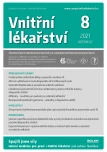Renal parenchymal hypertension: relevant new aspects
Authors:
Jan Vachek 1,2; Oskar Zakiyanov 1; Kateřina Oulehle 2; Hana Ciferská 3; Vladimír Tesař 1
Authors‘ workplace:
Klinika nefrologie 1. LF UK a VFN v Praze
1; Interní oddělení a hemodialyzační středisko, Klatovská nemocnice, a. s.
2; Revmatologický ústav a Revmatologická klinika 1. LF UK, Praha
3
Published in:
Vnitř Lék 2021; 67(8): 479-484
Category:
Review Articles
Overview
Renal parenchymal disease is the most common cause of secondary hypertension, accounting for up to 5% cases of all cases of systemic hypertension. Renal parenchymal hypertension occurs as a complication of a wide variety of glomerular and tubulointerstitial diseases and may aggravate the decline of kidney function. The pathophysiology of renal parenchymal hypertension represents a combined interaction of the impaired sodium handling leading to volume expansion, alteration of the renin-angiotensin system, abnormalities in endogenous vasodepressor compounds and possibly enhanced activity of vasoactive substances. Renal parenchymal hypertension can occur in acute and chronic kidney disease, manifesting early in the renal function impairment. It often requires complex pharmacological treatment of blood pressure and is prognostically unfavorable in terms of cardiovascular and renal complications. This form of secondary hypertension can often be successfully treated by therapy of the underlying renal disease. In case of insufficient blood pressure compensation, renal impairment progresses. The aim of this paper is to give a brief overview of renoparenchymatous hypertension, current diagnostic possibilities and principles of therapy.
Keywords:
arterial hypertension – diabetic kidney disease – chronic kidney disease – renoparenchymatous hypertension
Sources
1. Haffner D, Khalil M. Hypertonie. Pädiatrie. 2019; 485-491. doi:10.1007/978-3-662-57295-5_21.
2. Charles L, Triscott J, Dobbs B. Secondary Hypertension: Discovering the Underlying Cause. Am Fam Physician. 2017 Oct 1; 96(7): 453–461. PMID: 29094913.
3. Brooks B, Byers LW, Muirhead EE et al. Purification of class I medullipins from the venous effluent of isolated normal kidneys perfused under high pressure with saline. Blood Press 1994; 3 : 407–417.
4. Muirhead EE, Brooks B, Byers LW. Biologic differences between vasodilator prostaglandins and medullipin I. Am J Med Sci 1992; 303 : 86–89.
5. Mattson DL. Importance of the renal medullary circulation in the control of sodium excretion and blood pressure. American Journal of Physiology‑Regulatory, Integrative and Comparative Physiology 2003; 284 : 1, R13–R27.
6. Kohan DE. Endothelin, hypertension and chronic kidney disease: new insights. Curr Opin Nephrol Hypertens. 2010; 19(2): 134-139. doi: 10.1097/MNH.0b013e328335f91f.
7. Chen NX, Srinivasan S, O’Neill K, Nickolas TL, Wallace JM, Allen MR, Metzger CE, Creecy A, Avin KG, Moe SM. Effect of Advanced Glycation End‑Products (AGE) Lowering Drug ALT - 711 on Biochemical, Vascular, and Bone Parameters in a Rat Model of CKD‑MBD. J Bone Miner Res. 2020 Mar; 35(3): 608-617. doi: 10.1002/jbmr.3925. Epub 2019 Dec 30. PMID: 31743501.
8. Lioufas N, Hawley CM, Cameron JD, Toussaint ND. Chronic Kidney Disease and Pulse Wave Velocity: A Narrative Review. Int J Hypertens. 2019;2019 : 9189362. Published 2019 Feb 17. doi:10.1155/2019/9189362.
9. Chen C, Wang C, Hu C et al. Normoalbuminuric diabetic kidney disease. Front. Med. 11, 310–318 (2017). https://doi.org/10.1007/s11684-017-0542-7
10. Vistisen D, Andersen GS, Hulman A, Persson F, Rossing P, Jørgensen ME. Progressive decline in estimated glomerular filtration rate in patients with diabetes after moderate loss in kidney function—even without albuminuria. Diabetes Care 2019; 42 : 1886–1894 pmid:31221677.
11. Maksoud AAA, Sharara SM, Nanda A, Khouzam RN. The renal resistive index as a new complementary tool to predict microvascular diabetic complications in children and adolescents: A groundbreaking finding. Ann. Transl. Med. 2019; 7 : 422. doi: 10.21037/atm.2019. 08. 65.
12. Rovin BH, Adler SG, Barratt J et al. Executive summary of the KDIGO 2021 Guideline for the Management of Glomerular Diseases, Kidney International, Volume 100, Issue 4, 2021, Pages 753-779, ISSN 0085-2538, https://doi.org/10.1016/j.kint.2021. 05. 015.
13. Murphy T P, Cooper C J, Dworkin L D, Henrich W L, Rundback J H, Matsumoto A H, Jamerson K A, D‘Agostino R B. (2005). The Cardiovascular Outcomes with Renal Atherosclerotic Lesions (CORAL) study: Rationale and methods. Journal of Vascular and Interventional Radiology, 16(10), 1295-1300. https://doi.org/10.1097/01.RVI.0000176301.69756.28
14. Heerspink HJL, Stefánsson BV, Correa‑Rotter R, Chertow GM, Greene T, Hou FF, Mann JFE, McMurray JJV, Lindberg M, Rossing P, Sjöström CD, Toto RD, Langkilde AM, Wheeler DC; DAPA‑CKD Trial Committees and Investigators. Dapagliflozin in Patients with Chronic Kidney Disease. N Engl J Med. 2020 Oct 8; 383(15): 1436-1446. doi: 10.1056/ NEJMoa2024816. Epub 2020 Sep 24. PMID: 32970396.
15. Dumann E, Menne J. SGLT2-Inhibitoren: Was gibt es Neues?. Nephrologe 16, 241–255 (2021). https://doi.org/10.1007/s11560-021-00511-4.
16. Puleo F, Kim K, Frame AA, Walsh KR, Ferdaus MZ, Moreira JD, Comsti E, Faudoa E, Nist KM, Abkin E, Wainford RD. Sympathetic Regulation of the NCC (Sodium Chloride Cotransporter) in Dahl Salt‑Sensitive Hypertension. Hypertension. 2020 Nov;76(5):1461 - 1469. doi: 10.1161/HYPERTENSIONAHA.120.15928. Epub 2020 Sep 28. PMID: 32981364; PMCID: PMC7727920.
17. Püschel et al. Taschenlehrbuch Biochemie, Thieme, 2019.
18. Whelton PK, Carey RM, Aronow WS et al. 2017ACC/AHA/AAPA/ABC/ACPM/AGS/APhA/ ASH/ASPC/NMA/PCNA Guideline for the Prevention, Detection, Evaluation, and Management of High Blood Pressure in Adults: Executive Summary: A Report of the American College of Cardiology/American Heart Association Task Force on Clinical Practice Guidelines. Hypertension 2018; 71 : 1269–1324.
19. Williams B, Mancia G, Spiering W et al. 2018 ESC/ESH Guidelines for the management of arterial hypertension. Eur Heart J 2018; 39 : 3021–3104.
Labels
Diabetology Endocrinology Internal medicineArticle was published in
Internal Medicine

2021 Issue 8
Most read in this issue
- Renal parenchymal hypertension: relevant new aspects
- SGLT2 inhibitors – a new pillar for the treatment of heart failure
- Optimal potassium levels in patients with heart failure
- Antibiotic treatment issues in patients with COVID-19
